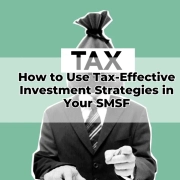How to Make the Most of Salary Sacrificing for Retirement Savings
Table of Contents
ToggleIn the ever-evolving world of retirement planning, salary sacrificing remains one of the most tax-effective and underutilised strategies available to Australian employees. When used intelligently, it offers a streamlined path to bolstering retirement savings, reducing taxable income, and leveraging superannuation benefits. Yet, many individuals fail to optimise this vehicle due to misinformation or lack of guidance. As a Toowoomba Financial Adviser, I often see significant potential untapped.
Salary sacrificing can substantially accelerate retirement preparedness without dramatically impacting your take-home pay. But to harness its full potential, you must understand how it integrates with broader financial strategies, compliance rules, and long-term objectives. This article explores the ins and outs of salary sacrificing, ensuring you’re equipped to make sound, strategic choices for a prosperous retirement.
What is Salary Sacrificing?
Salary sacrificing, also referred to as salary packaging, involves an agreement between an employee and employer to forgo a portion of pre-tax income in exchange for benefits-most notably, superannuation contributions. This voluntary arrangement redirects earnings directly into a chosen benefit before income tax is applied.
When salary is sacrificed into superannuation, it’s taxed at a concessional rate of 15% rather than the individual’s marginal tax rate, which could be significantly higher. This tax advantage alone makes it an attractive strategy for mid-to-high income earners looking to boost their retirement corpus. It’s not about earning more-it’s about keeping more of what you earn by using the tax system to your advantage.
The key is ensuring the arrangement is properly structured and compliant with Australian Taxation Office (ATO) guidelines. Working with a qualified Financial Adviser in Toowoomba can help ensure that salary sacrificing is both effective and aligned with your overall financial goals.
Why Salary Sacrificing is a Smart Retirement Strategy
Salary sacrificing is more than a tax strategy-it’s a disciplined and consistent approach to long-term wealth creation. By committing pre-tax income to superannuation, individuals can build a more substantial retirement fund with minimal lifestyle compromise.
One of the critical advantages is the compounding effect of early contributions. Starting salary sacrifice earlier in your career allows for decades of growth, significantly increasing the value of your superannuation over time. Additionally, because it is automated and often deducted directly from payroll, salary sacrificing removes emotional decision-making from investing.
This method also shields contributions from unnecessary consumption. Unlike after-tax income, which is often diverted towards discretionary spending, salary-sacrificed amounts are locked away for retirement. This enforces a powerful saving habit while reducing taxable income, providing both short-term tax relief and long-term security.
Eligibility and Income Considerations
Not everyone benefits equally from salary sacrificing. It’s particularly advantageous for those on middle to high incomes, where marginal tax rates exceed the superannuation concessional tax rate. However, lower-income earners may find limited benefit after considering the opportunity cost of reduced cash flow.
To be eligible, the arrangement must be formalised before the income is earned-retroactive salary sacrifice is not permitted. This is where planning becomes crucial. The timing of implementation, the amount to sacrifice, and alignment with annual concessional caps are all factors that can influence effectiveness.
It’s also worth noting that salary sacrificing may affect other entitlements, such as HELP repayments, Medicare levies, and Centrelink benefits. A comprehensive analysis by a Financial Planning Toowoomba expert is necessary to ensure the strategy is suitable for your income level and personal circumstances.
Concessional Contributions Caps
Salary sacrificed amounts fall under the concessional contributions category. These are contributions made into super where tax has not yet been paid and include both employer Super Guarantee contributions and salary sacrifice amounts.
As of the 2024-25 financial year, the concessional contributions cap is $30,000 per annum. Breaching this cap can result in penalty tax and additional administrative complexity, as excess contributions are taxed at the individual’s marginal rate, minus a 15% offset.
Understanding this limit is critical. For individuals who also receive generous employer contributions or make personal deductible contributions, it’s easy to unintentionally exceed the cap. A well-planned strategy should include careful monitoring of total concessional contributions and, where appropriate, consider the use of carry-forward unused cap amounts from previous years if eligible.
The Role of Carry-Forward Contributions
One of the most compelling recent developments in superannuation planning is the introduction of carry-forward contributions. This feature allows individuals to access unused portions of their concessional contributions cap from the previous five financial years, provided their total superannuation balance is below $500,000 at 30 June of the prior year.
This allows for greater flexibility and strategic lump-sum contributions, particularly in years where taxable income spikes-such as from bonuses, investment sales, or business proceeds. It also benefits individuals who may have had disrupted income flows in earlier years due to career breaks or part-time work.
An Online Financial Adviser can assist in calculating available carry-forward amounts and incorporating them into a broader salary sacrificing strategy to maximise concessional tax benefits while staying within legislative boundaries.
Tax Benefits and Effective Tax Rates
One of the core advantages of salary sacrificing lies in its taxation treatment. Instead of being taxed at your marginal rate-potentially as high as 47%-salary-sacrificed contributions are taxed at just 15% when entering your super fund. This differential can lead to substantial tax savings over time.
Consider an individual on a marginal tax rate of 39% including Medicare. Redirecting $10,000 of income via salary sacrifice into superannuation could result in tax savings of approximately $2,400 per annum. Multiply that over several decades, and the cumulative advantage is considerable.
However, the 15% tax on concessional contributions is not always the final tax. Individuals with incomes above $250,000 may be subject to an additional 15% tax (Division 293 tax), effectively reducing the overall benefit. This highlights the importance of personalised tax planning to ensure optimal strategy execution.
How to Implement Salary Sacrificing with Your Employer
Implementing a salary sacrifice arrangement is relatively straightforward but requires careful documentation. The agreement must be made prospectively-before the income is earned-and should be documented clearly with your employer.
Typically, the payroll department or HR team will have a standard form or process in place. You will need to nominate the amount or percentage of pre-tax salary to be sacrificed and the destination super fund.
It’s crucial to ensure the superannuation contributions are made consistently and reported correctly. Errors in implementation-such as misclassifying after-tax contributions or exceeding contribution caps-can trigger compliance issues or negate potential tax benefits. Partnering with a Financial Adviser in Toowoomba can provide reassurance that your arrangement is structured properly.
Common Pitfalls to Avoid
While salary sacrificing offers myriad benefits, there are common pitfalls that can erode its effectiveness if not carefully managed. Chief among them is exceeding the concessional contribution cap, leading to additional tax liabilities and potentially reducing Centrelink entitlements in retirement.
Another frequent mistake is failing to consider cash flow impacts. Sacrificing too much income too soon may place unnecessary strain on day-to-day finances, especially for individuals with mortgages, children, or other high living expenses.
Some employees also incorrectly believe that employer Super Guarantee contributions are separate from salary sacrificing. In reality, they count towards the same concessional cap. Without accurate tracking, it’s easy to breach thresholds unknowingly. Regular reviews and professional guidance are key safeguards against these errors.
Strategic Timing and Age Considerations
The timing of salary sacrifice contributions can make a significant difference. For individuals approaching retirement, aggressive salary sacrificing in the final decade of work can dramatically increase superannuation balances while reducing taxable income at a time when earnings are typically at their peak.
Younger workers, meanwhile, benefit more from the compounding growth of earlier contributions. The longer the funds remain invested in super, the greater the accumulation due to reinvested earnings and market appreciation.
There’s also a strategic angle to consider for those aged over 60 who can access their super through Transition to Retirement (TTR) strategies. This can allow you to supplement reduced take-home pay from salary sacrificing while still drawing income from your super-effectively maintaining lifestyle while supercharging retirement savings.
Integrating Salary Sacrificing into Broader Retirement Planning
Salary sacrificing should never be approached in isolation. It is one cog in a well-oiled financial strategy that includes investments, debt management, insurance, estate planning, and retirement income forecasting. Understanding how it interacts with each element is vital to avoid sub-optimisation.
For example, aggressively sacrificing salary into super may limit liquidity needed for property investment or debt repayments. It can also affect eligibility for certain government benefits and rebates. A holistic review by a retirement-focused Financial Adviser ensures alignment between short-term goals and long-term aspirations.
When tailored correctly, salary sacrificing can work in tandem with other strategies-such as downsizer contributions, spouse contributions, and recontribution strategies-to deliver a robust and tax-efficient retirement plan.
When to Seek Professional Advice
While the concept of salary sacrificing appears simple, its implementation and optimisation demand professional insight. Factors such as income fluctuations, family tax implications, legislative changes, and superannuation fund performance all play a role in the overall outcome.
A Financial Adviser in Toowoomba can provide personalised modelling to quantify benefits, forecast retirement balances, and manage tax exposure. More importantly, they ensure the strategy is not only compliant but continually monitored as laws, caps, and personal circumstances evolve.
With the right guidance, you can confidently use salary sacrificing as a powerful instrument for building long-term wealth while enjoying the benefits of strategic tax management today.
Conclusion
Salary sacrificing is more than a financial technique-it’s a forward-looking mindset. By redirecting a portion of today’s income into tomorrow’s wealth, you pave the way for a retirement that is not only financially secure but also free from avoidable stress.
At Wealth Factory in Toowoomba, we specialise in helping individuals make informed, confident decisions about their superannuation and broader financial lives. Whether you’re starting to explore retirement planning or looking to refine your existing strategy, personalised advice from an Online Financial Adviser can illuminate the path forward.
Now is the time to take control of your retirement savings. Harness the power of salary sacrificing and set the foundations for a financially independent future.









